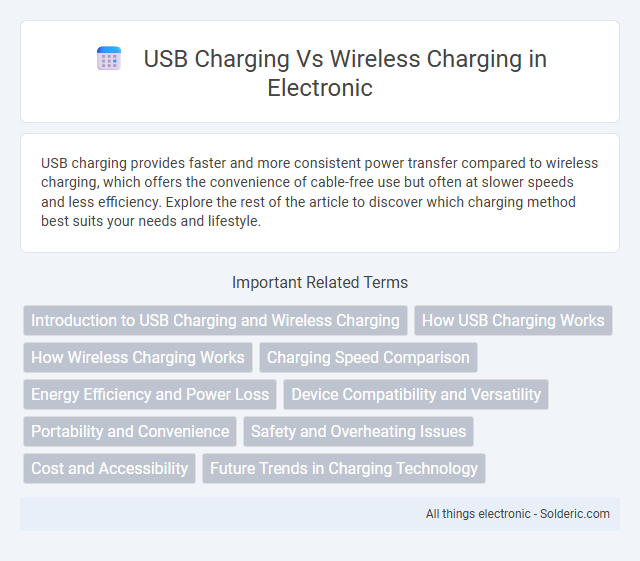USB charging provides faster and more consistent power transfer compared to wireless charging, which offers the convenience of cable-free use but often at slower speeds and less efficiency. Explore the rest of the article to discover which charging method best suits your needs and lifestyle.
Comparison Table
| Feature | USB Charging | Wireless Charging |
|---|---|---|
| Charging Speed | Faster; up to 100W with USB-C Power Delivery | Slower; typically 5W to 15W |
| Compatibility | Universal; works with most devices using USB cables | Limited to Qi-compatible devices |
| Convenience | Requires cable connection | Cable-free; just place device on charger pad |
| Port Wear | Possible wear due to frequent plugging/unplugging | No port wear; contactless charging |
| Energy Efficiency | High efficiency; minimal energy loss | Lower efficiency; energy loss due to induction |
| Price | Generally cheaper cables and adapters | More expensive charging pads |
| Mobility During Charging | More flexible; use device while charging | Less flexible; device must stay on charging pad |
Introduction to USB Charging and Wireless Charging
USB charging delivers power through a direct cable connection, offering faster and more efficient energy transfer for your devices. Wireless charging uses electromagnetic fields to transmit energy without cables, providing convenience but typically slower charging speeds. Understanding these methods helps you choose the best charging solution for your device's needs and lifestyle.
How USB Charging Works
USB charging transfers power through a cable connected between a power source and a device, using direct current (DC) electricity regulated by protocols such as USB Power Delivery (USB PD) for efficient voltage and current management. The USB cable's internal wires carry electrical energy from a power adapter or computer USB port to the device's battery, enabling rapid and consistent charging speeds. Unlike wireless charging, USB charging minimizes energy loss by delivering power with minimal resistance and ensures compatibility across a wide range of devices including smartphones, tablets, and laptops.
How Wireless Charging Works
Wireless charging works through electromagnetic induction, where a charging pad creates an alternating electromagnetic field that transfers energy to a receiver coil inside the device. This method eliminates the need for physical connectors, reducing wear and tear on ports and cables. Efficiency and charging speed depend on the alignment and distance between the charging pad and the device's receiver.
Charging Speed Comparison
USB charging delivers faster power transfer with USB-C Power Delivery (PD) technology reaching up to 100W and enabling rapid device charging within minutes. Wireless charging typically offers lower wattage, often maxing out at 15W for Qi-certified chargers, resulting in slower charging times. The efficiency of USB charging is higher due to direct cable connection, reducing energy loss compared to wireless charging's electromagnetic induction method.
Energy Efficiency and Power Loss
USB charging demonstrates higher energy efficiency with minimal power loss, as direct cable connections facilitate faster and more stable power transfer rates typically exceeding 90%. Wireless charging, relying on electromagnetic induction, inherently experiences energy losses ranging from 20% to 40%, due to heat generation and alignment issues between the transmitter and receiver coils. Optimizing charging pad alignment and using advanced coil technology can reduce power loss but often cannot match the efficiency levels of wired USB charging standards such as USB Power Delivery (USB PD).
Device Compatibility and Versatility
USB charging supports a wide range of devices across various brands and models, enabling compatibility with smartphones, tablets, laptops, and other electronics using standardized connectors like USB-C and Lightning. Wireless charging, primarily based on the Qi standard, is compatible with most modern smartphones and select wearables but may face limitations with older or non-Qi-enabled devices. USB chargers offer greater versatility due to their widespread adoption and the ability to charge multiple device types with a single cable, while wireless charging prioritizes convenience but often lacks universal device support.
Portability and Convenience
USB charging offers superior portability with universal compatibility across various devices and the ability to charge faster using different power adapters. Wireless charging increases convenience by eliminating cable clutter and allowing effortless device placement on charging pads, though it tends to be less efficient and slower. Your choice depends on whether you prioritize the compactness and speed of USB charging or the hassle-free experience of wireless charging.
Safety and Overheating Issues
USB charging typically offers better control over power delivery, reducing the risk of overheating through built-in safety mechanisms like overcurrent protection and voltage regulation. Wireless charging generates more heat due to energy loss during transmission, which can lead to increased device temperature and potential battery strain. You should ensure your charger, whether wired or wireless, complies with safety standards to minimize overheating risks and protect your device's battery health.
Cost and Accessibility
USB charging is generally more affordable and widely accessible due to its established technology and compatibility with numerous devices and power sources. Wireless charging tends to be more expensive, requiring specialized chargers and devices, which can limit accessibility for budget-conscious users. The ubiquity of USB ports in public and private spaces further enhances cost-effectiveness and convenience compared to the relatively niche infrastructure for wireless charging.
Future Trends in Charging Technology
Future trends in charging technology indicate a shift towards ultra-fast wireless charging with improved energy efficiency, surpassing traditional USB charging speeds. Advancements in magnetic resonance and resonant inductive coupling promise longer range and simultaneous multi-device charging capabilities. Integration of smart sensors and AI in charging systems will optimize power delivery, reduce heat generation, and enhance battery lifespan across various electronic devices.
USB charging vs Wireless charging Infographic

 solderic.com
solderic.com